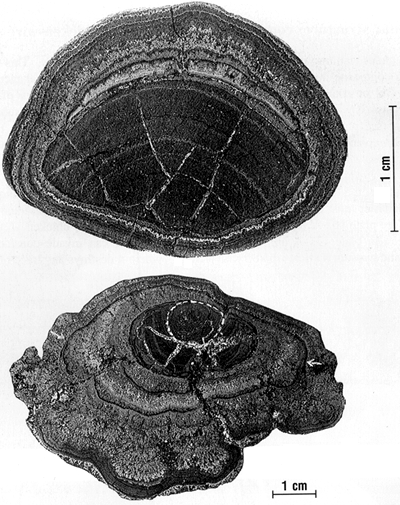
Sections of manganese nodules
Plate 172

Sections of manganese nodules
Plate 172
Nodular structures do not occur only in continental sediments and soils. They are found in marine deposits, too: chert nodules, for example, are common in pelagic limestones of European Mesozoic successions, both in well-lithified formations of the Mediterranean region and the famous Chalk of the Paris Basin and the English Channel (the "white cliffs of Dover").
Manganese nodules pave vast expanses of the deep ocean floor; the samples pictured here were dragged from a depth of 5,000 m in the Pacific.3 They rest on very fine clays of red or brown color, whose rate of accumulation is extremely low; the nodules grow even more slowly (less than 1 mm per thousand years) but nonetheless are only half-buried by the clay. The are probably moved from time to time by currents or organisms searching for food.
Manganese is probably extracted from seawater by microorganisms and fixed around a tiny nucleus. The coating is not symmetrical, and the internal structure of nodules is eccentric. This means that the growth is not a continuous process, as confirmed by the discordant contact between sets of laminae. Moreover, it is slower on the upper side, as can be seen from the greater thickness of the lower, buried side. This suggests that the manganese supply comes mostly through interstitial water. Together with manganese, other metal ions (cobalt, iron, platinum, nickel, etc.) are precipitated in the nodules, which should be called polymetallic. The concentrations are high and would make the nodules an economic resource were it not for the formidable technical and environmental problems that their mining poses.
Red abyssal clays are a typical residual sediment, concentrating insoluble impurities of calcareous and siliceous organic particles that are dissolved below a certain depth. Carbonate skeletons, in particular, are attacked by slightly acidic, CO2-rich abyssal waters, and do not "survive" below a critical limit, the CCD (carbonate compensation depth).
Note 3: U. Von Stackelberg and V. Marchig. 1987. Manganese nodules from the Equatorial North Pacific Ocean. Geol. Jahrbuch D87: 123-227. Back.